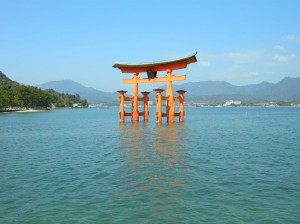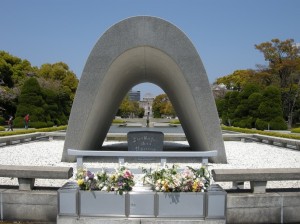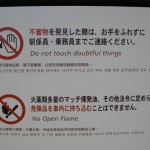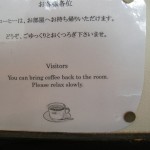そして今終わりはここにある
私は最後の幕に直面
私の友人は、私はそれを明確に言っておこう
私は確信しているうち、私の場合を述べます
私は完全な人生を生きてきた
私は一人ひとりの高速道路を走行し
これよりもはるかに多くの、そしてより多くの
私はそれを私の方法をやった
Author Archives: GrumpyGub
Hiroshima
あなたの祝福を数える
We went down to the dock to get a ferry to the mainland but, before boarding, decided to see the sights at the Itsukushima Shinto shrine. (Try saying that after a drop of saki). The shrine has large Torii gate that, when the tide is in, appears to float on the water. It’s supposed to be one of the most “magical” sites in the world. Just looked to me like it could do with a lick of paint.
So, on to the mainland…
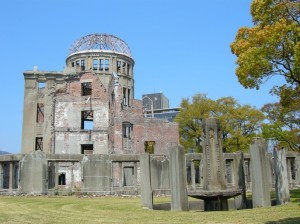 We stood beside the ruined Genbaku dome today – Hiroshima’s Ground Zero. Had we been there at 8.15am on 6th August 1945 we would have been looking into the fires of hell. We’d have been blinded by the light of a thousand suns, then incinerated and blown away as radioactive dust in a fearsome wind. At least fifty thousand souls were sent to oblivion in an instant. Another hundred thousand died of injuries and radiation sickness over the following weeks and months. Sixty eight years later it’s a tourist attraction. You can’t go to Japan and not visit Hiroshima. What happened here, and in Nagasaki, was one of the most significant events in human history.
We stood beside the ruined Genbaku dome today – Hiroshima’s Ground Zero. Had we been there at 8.15am on 6th August 1945 we would have been looking into the fires of hell. We’d have been blinded by the light of a thousand suns, then incinerated and blown away as radioactive dust in a fearsome wind. At least fifty thousand souls were sent to oblivion in an instant. Another hundred thousand died of injuries and radiation sickness over the following weeks and months. Sixty eight years later it’s a tourist attraction. You can’t go to Japan and not visit Hiroshima. What happened here, and in Nagasaki, was one of the most significant events in human history.
Standing there and looking around, apart from the dome, you wouldn’t know that anything major had ever happened there. Hiroshima was annihilated that day and has been completely rebuilt. It’s a city that has, literally, risen from the ashes. It’s a modern, vibrant, forward-looking place. They haven’t forgotten their history, of course not – but they don’t seem to mope about it. Life goes on and as far as I could see, Hiroshima just gets on with it. There’s a lesson there for all of us. If you can recover from a nuclear attack then surely you can find a way to quit arguing about flags.
Reserved? I think not.
国は国に語ります
Before we went on this trip several people had mentioned how we would find the Japanese stand-offish, reserved and unwilling to engage with foreigners. I’m not sure why this idea is prevalent but I can assure you that the opposite is true. I have rarely met such a polite, friendly and helpful bunch of people. The incessent bowing takes a bit of getting used to but it quickly becomes second nature. Whenever we have asked for help with directions, the people involved have, without exception, been more than helpful – despite the language difficulty; very few of them speak English. On more than one occasion our helper has actually TAKEN us to where we wanted to go. And they really seem to like it if you try to speak Japanese.
People here are well used to hearing westerners saying the standard things like arigatou or sayonara. What really chuffs them is if you say less obvious things like ohayogozaimasu (good morning) or oyosunimasai (good night). If you really want to impress you can say to a restuarant owner Gochisousama deshita, (may I humbly offer my thanks for the trouble you went to in preparing such a delicious repast)
We were getting off a train the other day and Maire needed the loo. She asked me how to ask where it was and I told her. She marched up to the nearest official and said “Sumimasen, toire wa doko desuka?”. The chap made a grand pointing gesture and said something complicated that I didn’t understand, but I did catch the word “asoko” which means “over there”. Hey! We have communication.
On another occasion we had just boarded a fairly crowded train. A young couple noticed my stick and offered us their seats. We sat down, with much “arigato” and “konichi wa”, opposite two ladies of a certain age who smiled indulgently while this was going on. One of them said something which was too fast for me. Another passenger translated. “She wants to know if you two are married”. I replied “Kanojo wa watashi no okusan desu” (she is my wife). Well, I swear to god, I thought they were going to explode with delight, huge face-breaking smiles and hand clapping. Half the carriage joined in as well. Like I said, they really, really like it when you make the effort.
The language barrier
翻訳で失わ
 Apart from one MacDonalds, I don’t think I’ve understood anything that I’ve eaten here. Tonight was no different. We went to a mall inside the main Kyoto subway station. A vast underground cathedral of consumption with a huge variety of shops including many restaurants. We eventually chose one which Maire assured me was a tempura joint. (As if I knew what that meant.) The menu was written in traditional kanji, so we had no mission of understanding it. The young waitress, god love her, had no English, so we just pointed at words and said “that’ll do me”. I started with LOL followed by OMG and finished up with WTF.
Apart from one MacDonalds, I don’t think I’ve understood anything that I’ve eaten here. Tonight was no different. We went to a mall inside the main Kyoto subway station. A vast underground cathedral of consumption with a huge variety of shops including many restaurants. We eventually chose one which Maire assured me was a tempura joint. (As if I knew what that meant.) The menu was written in traditional kanji, so we had no mission of understanding it. The young waitress, god love her, had no English, so we just pointed at words and said “that’ll do me”. I started with LOL followed by OMG and finished up with WTF.
To be fair, it was all really quite nice.
Signs which tell you you’re not at home …
Ryokan my arse!
私はカイロプラクターが必要
Many Americans still think the Irish sit around turf fires under a thatched roof and disport themselves like extras from “The Quiet Man” This is a myth that the Irish Tourist people have made very little effort to dispel. After all, it’s good business. But nobody in their right minds, apart from a few lunatics, actually wants to live like that nowadays.
The same sort of thing appears to happen in Japan. When we were with our guide in Tokyo, we were looking at an exhibition depicting a traditional Japanese house. I said that I rather liked it’s minimalist lines. She gave me a look and the penny dropped. “I suppose this seems very old-fashioned to you”, I said. “Yes”, she replied, “my grandfather’s house was like that – I hated it. Nobody wants to live like that anymore”
When you get right down to it, a ryokan is just a shed with a very small table and a couple of sleeping bags on the floor. Yes, it’s fun for about 15 minutes but then reality sets in. There is nowhere to sit! Now if you happen to be a young Russian gymnast that’s probably fine but the likes of me very quickly discovers aches and pains where I didn’t know I had something to hurt. It doesn’t help that Mrsmcanespie-san finds my rolling-about-the-floor antics hererius. I had to ask for a chair to be brought in.
So, no – we won’t be building a ryokan in the back garden any time soon.
Faster than a speeding bullet …
これらには、奇跡と驚異の日です
 So here’s a thing – We’re sitting comfortably on the fantastically streamlined Shinkansen “Bullet” train. The GPS on my phone tells me that we are ambling along at 150mph. I’m talking to a web server somewhere in North America, preparing a post for our blog by means of a rock solid, high speed WiFi internet connection courtesy of a little box of tricks in my jacket pocket. Why am I doing this? Well, frankly, because I can. I am Otaku, it’s what we do. We’ve come a long way from two tin cans and a bit of string.
So here’s a thing – We’re sitting comfortably on the fantastically streamlined Shinkansen “Bullet” train. The GPS on my phone tells me that we are ambling along at 150mph. I’m talking to a web server somewhere in North America, preparing a post for our blog by means of a rock solid, high speed WiFi internet connection courtesy of a little box of tricks in my jacket pocket. Why am I doing this? Well, frankly, because I can. I am Otaku, it’s what we do. We’ve come a long way from two tin cans and a bit of string.
Akihabara
The Japanese have a word for people like me. (Stop sniggering at the back there, Barclay!)
What English speakers call “Geeks” the Japanese call “Otaku”. I like things that go Beep, I like making, fixing and fiddling with things that involve the flow of electrons. So yes, I’m a Geek. Doesn’t do anybody any harm. But these Otaku add into the mix a rather alarming addiction to Anime and Manga as well. The spiritual home of Otaku in Tokyo is the “Electric Town” district, more properly known as Akihabara.
Always willing to commune with a kindred mind, it was off to Akihabara for an electronic fix. The place was swarming with Otaku, most of whom were aproximately one third my age but sharing a liking for all things electronic. Now this Anime thing – I’m afraid I don’t get it, neotenous women with big eyes and high pitched voices dressed as cartoon characters – I’d rather leave that can of worms unopened.
Leaving that aside, the best thing about Akihabara is the sheer number and variety of businesses. I’m not talking about the Sony, Sega, Mitsubishi and Toshiba megastores. They’re all there, but leave that to the tourists wanting to buy duty-free Blu-Ray players. The true Otaku builds his own, and you get the bits to do that from the multitude of back-street small traders. It’s the niche marketing that I find interesting. Who would have thought that there was a living to be made selling connecting wire (and nothing else) to home enthusiasts? Another stall sells every kind of switch you could possibly think of. You want one of those old-fashioned double-pole open jobs that Frankenstein used to use to control the lightning to wake up the monster? you’ll get one here. How about a thermionic triode valve to fix your grandad’s wireless set? You want a Mullard CV4024? Certainly sir! What power rating would you like? And the guys running the stalls are not pushy. They are quite happy to let you browse and futer about without hassling you. I could have stayed there all day but it was time to move on.
Oh yea, and what Maire said about the park thing…
Day two…
The rain has stopped (for now) and it’s possible to see stuff again. This is the night-time view fom our hotel window. Those are Buddhist temples.
Regarding the pop quiz, that was a picture of the control panel (!) for the toilet in our en-suite bathroom.
It’s like sitting in a fighter jet cockpit. You get a heated seat and a variety of other “services” to chose from. Can’t quite make up my mind whether it’s decadent or brilliant.
Out to lunch
頂きます
After unpacking we slipped out to an eatery for some lunch. The menu was incomprehensible, even with the English translation. Eventually I ordered “Rixe in omulret with pork stew” while Maire had “Chickiken tatsuta, fried leek and ponzu vinegar with rice”
The Rixe was a bit weird but the Chickiken was actually rather tasty.
Ok, mocking the translation is a cheap shot, but I can’t help it. To be fair, I’m sure the locals find my attempts at Japanese to be laughable.
Pop quiz! First one to say what this photo is about wins an ice cream burger! (Oh yes, you can buy such a thing.)


